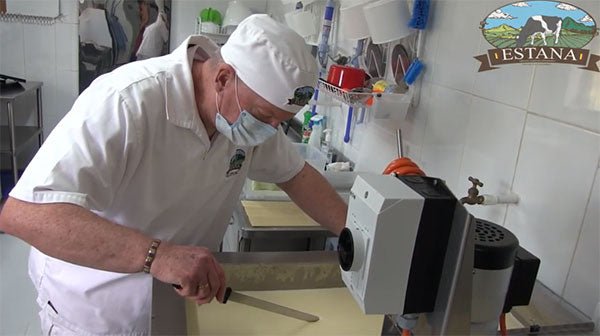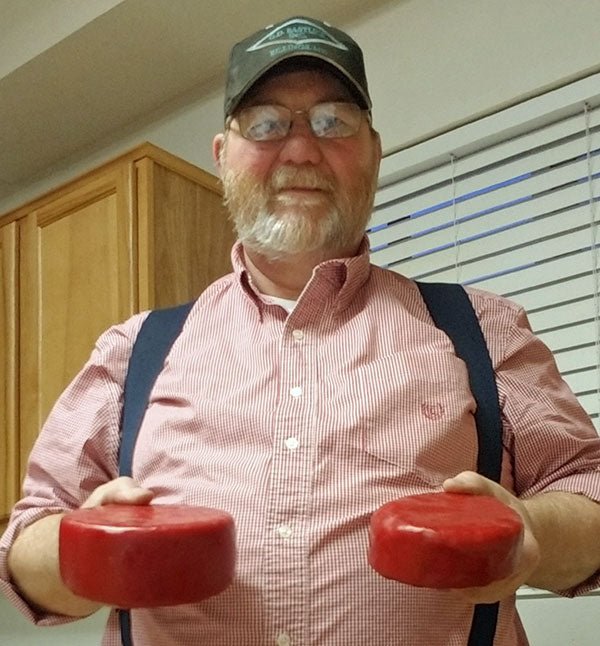
Stephen Cope and his wife, Ana
Interview with Stephen Cope, of Estana Queseria near Medellin, Colombia
by April O’Malley*
Stephen’s Story
I was born in Melbourne Australia. I am university educated, a keen field hockey player (even in my sixties) and I am a certified practicing accountant by profession. I started my own accounting practice in 1992, including some university lecturing and tutoring part time in the areas of small business practice and customer service.
I am an avid reader and gardener, a believer in self-sufficiency (a little!), well-traveled, and still doing it.

I married my wife, Ana Rubiela Castano Gil, a Colombian, in 1997. We left Australia to live in Colombia in May 2016 and are now full time residents.
We reside in Vereda el Portento, near El Retiro, in the State of Antioquia, just 20 miles (32 kilometres) south east of the city of Medellin, where the average temperature is 64-73F (18-23C) all year round and the humidity never drops below 75%. A cheesemakers paradise!

Stephen’s business is on the ground floor of his house.
While most people still shiver at the word “Colombia,” those of us who know the country well, see large mountains and hills, narrow valleys, great rivers, green pastureland, small villages, thousands of tiny farms and well fed animals. Colombia is also exceptionally well watered; its annual rainfall stands in excess of 100 inches per year.

Aerial view of his estate
Although Colombia has had a history of violence, the last twenty (20) years has seen a remarkable transformation as a result of various peace agreements with narco-terrorists and the dominance of a new generation.
There are two (2) wet seasons; March to May and October to mid-December. These are unique and ideal conditions for the making and storing of many hard cheeses. Estana’s cheese making workroom has an average temperature of around 64F (21C). With high humidity, it takes little effort to water the floor of the cheese cave to ensure that the humidity level is kept above 90%.

Stephen’s cave

His cheese vat
How I Got Into Cheesemaking
As part of Ana’s and my interest in being a little more self-sufficient, I decided to invest a few Saturdays with an organization called Cheeselinks Pty, Ltd, in Melbourne, Australia, who offered all day cheesemaking courses, run by Charlene Angus. She taught me to make Cheddar, Camembert and Ricotta. That knowledge was taken home when I began to make cheese on a regular basis. After 47 years of being a practicing accountant, I suddenly found something that I was very passionate about doing!

Whisking Manchego
My Experience with Cheesemaking
Camembert became my bane for a long time, until a cheesemaking friend all the way from Lahore, Pakistan visited and found out that the recipe I was using was totally wrong. Don’t believe everything you read in cheesemaking recipe books (I haven’t touched that book since.) Now my Camembert is almost prefect (I said almost).

Camembert during the initial draining stage
I never had any problems with Cheddar and, as I have taught Ana how to make Ricotta, she has assumed total responsibility for that cheese. Once I had sufficient confidence with the three I was taught, it didn’t take me long to start dabbling with other cheeses.

Cheddar curds
How/When I Decided to Go Commercial
During our many visits to Colombia between 1997 and 2016, we found out very quickly that Colombian cheese was bland, colorless and rubbery. In fact, their version of “Mozzarella” reminded us of a genuine bar of soap in a cellophane pack.
Whilst Colombia is not a great cheese eating nation, it has been given little opportunity to sample the great cheeses of the world. Imported varieties price most ordinary Colombians out of the market. Now that there are a substantial number of ex-patriot citizens from the USA, England, Canada, Australia, New Zealand, and much of Western Europe, their first complaint is their inability to find any cheese worth buying. What an incentive for a budding cheesemaker!


fourme d’Ambert


Where We Source Our Milk
The area we live in is full of small dairy cattle farms, so, it is not too difficult to acquire the milk that we need. We currently source milk from two of those farms. Their milk is combined during the filtering process, pasteurized and then the cheese making process begins. The drawback is that this is not a goat farm area and there are very few sheep. What sheep exist are simply bred for their meat and the owner has no interest in milking them.

Manchego, aging
Our Daily Routine
On Wednesday, milk is collected, pasteurized and left in the cave for skimmed milk to be created.
On Friday milk is collected, pasteurized and added to the skim milk for cheese making.
On Cheese Making Days:
7:00am Collecting milk from dairies (up to 42 gallons (160 litres))
7:30am Filtering and pasteurization
8:30am Cleaning and sanitizing of the cheese workroom and aging cave
9:30am Commencing cheese making
4:30pm Average conclusion of cheese making
11:00pm Possible redressing and repressing if hard cheese is being made
On Non-Cheese Making Days:
8:00am Possible pressing, brining, flipping during draining, cleaning, depending on cheese.
As the cheesery is the ground floor of our home, it can be accessed at any time during the day or evening, for activity to be undertaken when necessary.
We currently produce traditional Cheddar, Manchego, Emmental, Estana Azul (fourme d’Ambert), Feta, Ricotta, Petit Brie, Camembert, Queso Fresco (usually with added saffron infusion and herbs) and Parmesan. I consider Cheddar my favorite, but I also have a weakness for fourme d’Ambert and a good Camembert.

Estana Azul (Blue)

Our Biggest Challenge/Joy
Before I commence this section, it must be understood that both Colombia and many surrounding South American countries do not consider cheese as a staple food. In Colombia, the staples include frijoles (beans), maize (corn), carne (beef), platinos (a form of banana), arroz (rice) and arepas (a form of corn bread). Cheese is only a recent addition and most of it here is fresh cheese only, usually eaten on arepas at breakfast time. Colombians do not like strong, smelly, aged, or tangy anything, but particularly cheese.
The challenge here is to encourage their interest, and then encourage them to try it. The body language I see (with encouragement) is quite extraordinary. Some Colombians are very apprehensive, others are either adamant or downright scared to try anything new. However, with the end of civil conflict here, more overseas travel, and a new, more inquisitive generation, interest is increasing, albeit slowly.
Taste testing and gourmet markets have given Colombians an opportunity to sample a new range of cheeses, and we run tasting activities every month. Whilst it is the ex-patriots living here who have guaranteed our success, interest by paises (Colombian locals) is growing steadily, particularly in the areas of gourmet supermarkets, specialty cheese shops, charcuterias (delicatessens), and restaurants.
The biggest joy is watching the look on a local’s face when their attitude of abject fear changes to delight when they realize brie actually tastes good!

Blue, Emmental, Cheddar, Manchego and Brie
Advice for Future Cheese Makers
1. Just Getting Started
Try the simple cheeses first and perfect them before moving onto something a little more complicated. Take a few cheese making courses; it doesn’t need to be a full diploma. You need to decide whether you are serious or not. Don’t go out buying expensive equipment immediately; you will find your basics in the kitchen. Learn from day one the importance of being clean and keeping your “cheese making area” sanitized. If you have children, teach them to make it, not just watch and stick their dirty fingers in your milk!
2. Getting a Little More Serious
Develop a cheese making only area. It should not be part of general traffic flow through your home.
Stop sharing cheese making utensils with the evening meal. You should now start acquiring equipment used specifically for cheese making.
And, you should have a specific storage area for that equipment.
Start setting up “cheese making time” only in your weekly/monthly diary. In other words, everyone in the house knows when you are making cheese (so will the neighbors), and they are either going to be your helpers or they are not going to be around.
Buy a proper cheese making vat, specifically for cheese making. It could be a double boiler or it could be a single tray bain marie. Whatever you use, it will be for the making of cheese only.
Try a few more complicated cheeses, such as Feta, Brie and Camembert.
You will need to set up an aging facility, such as a wine fridge to store your cheeses. Begin writing up a logbook for each cheese made. Record both your successes and failures.
3. Going Commercial
Seek your local Health Department certification before you begin selling; some organisations will only deal with certified producers.
Register a business name as soon as possible, open a business bank account and find a good accountant.
You will need to find a good graphic artist; that person will design your logo, your stickers, your brochures and even your product description and price list.
Your early promotion will consist of cheese tastings, Facebook, Instagram and a basic website. Never be afraid to start small; you need to build your market, not to assume its size at the very beginning.
Be visual; people need to know exactly where you are. And separate your viewing area from your actual cheese working area.
You now need a proper cave; not a wine fridge.
And you will now need a proper cheese making vat; the double boiler will not produce enough cheese any more.
Stick to your established cheeses; don’t try to experiment with large amount of milk too early. And if you are going to experiment, use a bain marie or large pot, not your cheese vat.
Set your prices at the beginning and only give discounts to those that buy regularly.
Estana Queseria
El Retiro, Antioquia, Colombia
Contact: fincaestana@aol.com
Facebook: EstanaQueseria17
Whatsapp (Ana): 318 339 6691
Instagram: estana_queseria
 *Many of you already know April, our office administrator, because she has been with our company (cheesemaking.com) for over a decade, cheerfully answering questions and taking orders.
*Many of you already know April, our office administrator, because she has been with our company (cheesemaking.com) for over a decade, cheerfully answering questions and taking orders.














































































































































